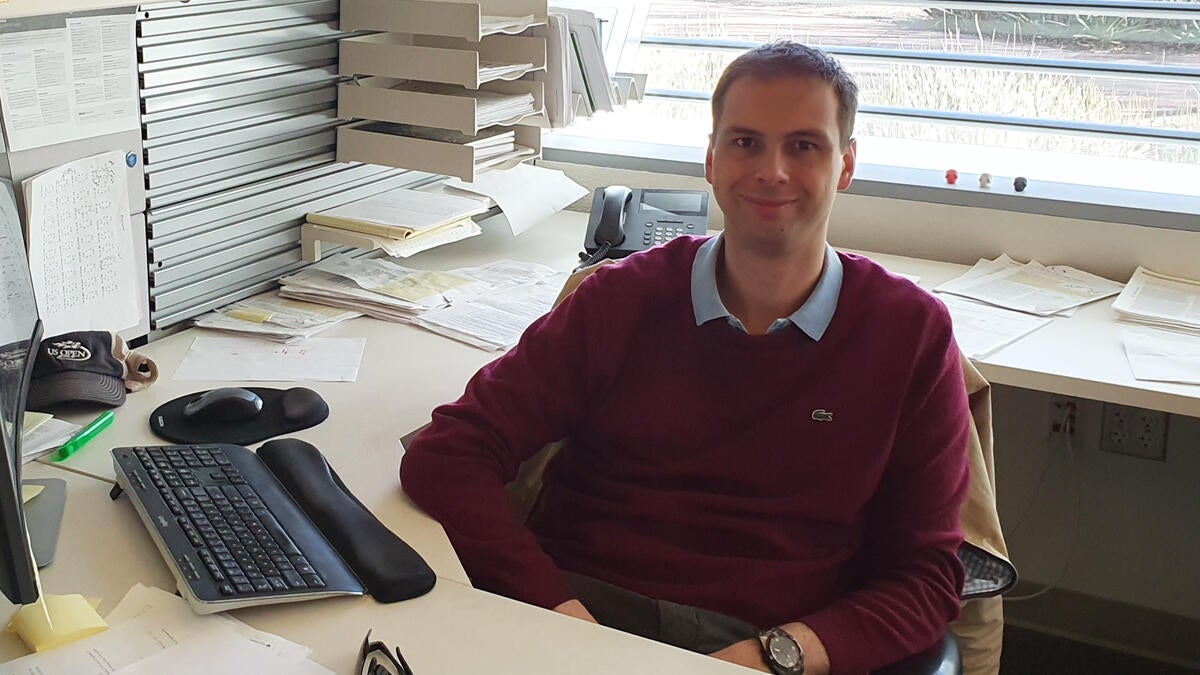ASU professor will develop new computer modeling framework for bio-nanotechnology with NSF CAREER award

Petr Šulc is an assistant professor at Arizona State University's School of Molecular Sciences and the Biodesign Center for Molecular Design and Biomimetics. Photo courtesy ASU
Petr Šulc, an assistant professor at Arizona State University's School of Molecular Sciences and the Biodesign Center for Molecular Design and Biomimetics, has recently earned a Faculty Early Career Development (CAREER) award from the National Science Foundation.
Šulc's lab is highly interdisciplinary and applies broadly the methods of statistical physics and computational modeling to problems in chemistry, biology and nanotechnology. The group develops new multiscale models to study interactions between biomolecules, particularly in the context of design and simulations of DNA and RNA nanostructures and devices.
“This research award will allow our lab to expand the scope of systems that we study and allow us to design a new class of nanodevices and nanomaterials that incorporate DNA, RNA and proteins, as well as other molecules,” explained Šulc. “Just as complex machines in our everyday use — planes, cars and chips in electronics — require sophisticated computer-aided design tools to make sure they perform a desired function, there is a pressing need to have access to such methods in the molecular sciences.”
Professor Tijana Rajh, director of the School of Molecular Sciences, said, “Petr Šulc and his group are doing extremely innovative molecular science, using the methods of computational chemistry and physics to study DNA and RNA molecules in the context of biology as well as nanotechnology. Our younger faculty members in the School of Molecular Sciences have an extraordinary record of achievement, and Professor Šulc is an exemplar in this regard.”
The prestigious CAREER program supports the early career development activities of teacher-scholars who most effectively integrate research and education within the mission of their organization. It provides five-year research grants to each recipient.
Bio-nanotechnology
DNA and RNA are the basic molecules of life. They fulfill many functions, including information storage and information transfer in living cells. They also have promising applications in the field of nanotechnology where designed DNA and RNA strands are used to assemble nanoscale structures and devices. As Šulc explains, “It is a little bit like playing with Lego blocks except that each Lego block is only a few nanometers (a millionth of a millimeter) in size, and instead of putting each block into the place where it should go, you put them inside a box and shake it randomly until only the desired structure comes out.”
This process is called self-assembly, and Šulc and his colleagues use computational modeling and design software to come up with the building blocks that reliably assemble into the shape one wants at nanoscale resolution.
“The promising applications of this field include diagnostics, therapeutics and building of new materials,” says Šulc. “My lab has developed the software to design these blocks, and we work closely with experimental groups at ASU as well as other universities in the U.S. and Europe. “
They are also interested in the application of machine learning methods to biological sequence ensembles and use neural networks to design DNA or RNA sequences that will specifically bind to a target protein of interest, such as the SARS-CoV-2 spike protein.
The challenges
Computer-aided design software is often used in our macroscale world to design computer chips, cars and planes so that the device operation can initially be tested and optimized in simulation. Construction at the nanoscale, however, presents multiple challenges. As opposed to our macroworld, nanostructures are typically obtained by self-assembly, where individual components randomly diffuse until they meet and assemble into a target structure.
In order to obtain more complex structures that will self-assemble in high yields, there is a need for a new simulation framework that can efficiently and, at the same time, accurately represent the assembly and function of the nanostructures.
Šulc’s lab will develop a new modeling framework that is capable of simulating self-assembled DNA nanostructures.
The research team will use this new framework to optimize nanostructure assembly for high yield and computationally design new types of reconfigurable nanostructures. Next, the team will extend the modeling platform to allow for the incorporation of other organic/inorganic molecules and materials.
Overall, this award will facilitate the creation of new nanodevices capable of performing complex tasks that would be difficult to realize experimentally without a sophisticated modeling platform. It will bring the field closer to large-scale industrial applications.
To realize the education component of the project, Šulc’s lab will develop new learning opportunities for university students and the general public. The main effort will involve developing an online citizen-science platform, where users can use the simulation platform to design and optimize structures themselves, enabling crowdsourcing of nanotechnology designs.
More Science and technology

ASU professor breeds new tomato variety, the 'Desert Dew'
In an era defined by climate volatility and resource scarcity, researchers are developing crops that can survive — and thrive —…

Science meets play: ASU researcher makes developmental science hands-on for families
On a Friday morning at the Edna Vihel Arts Center in Tempe, toddlers dip paint brushes into bright colors, decorating paper…

ASU water polo player defends the goal — and our data
Marie Rudasics is the last line of defense.Six players advance across the pool with a single objective in mind: making sure that…

